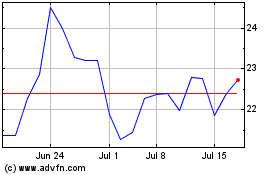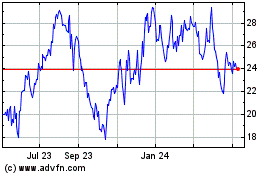Luxury Retailers Stand To Continue Producing Strong Numbers
April 11 2011 - 3:38PM
Dow Jones News
Upper-end retailers, like Saks Inc. (SKS) and Neiman Marcus
Group Inc., saw their fortunes dinged by the recession, but they
were the first to bounce back and their lead is likely to
continue.
Luxury customers, while thrown by the economic downturn, held
onto their jobs to a greater degree than lower-income consumers,
government data show. As a result, the effect on the upper end was
more psychological as they hunkered down, but were hardly
destitute.
"During the recession, people, shoppers at the high end still
had money, but there was embarrassment," said Barbara Kahn,
director of the Jay Baker Retailing Center at the University of
Pennsylvania's Wharton School. "Now, we're in a recovery where
there is less of a patina."
There is also greater wealth as the stock market has mounted a
significant recovery.
"The strength of our business--luxury--is typically tied to how
our customers feel about their personal financial situations," said
Julia Bentley, spokeswoman for Saks. "The financial markets are a
good barometer of this."
But customers are not in a freewheeling mood. "They remain very
discriminating in their purchases," Bentley said. "They are
responding to special, differentiated products" and a more
personalized shopping experience.
Some luxury retailers also say they have not really seen a
return of the "aspirational" customer--someone that wants to be
associated with the upper-end but pulled in their horns during the
recession. Mark Aaron, spokesman for Tiffany & Co. (TIF), cited
softness in "entry-level price point silver jewelry." For some
consumers, "The environment may be too difficult for them to make
that modest investment," Aaron said.
The still-restrained approach to spending and an aspirational
customer that remains relatively scarce could produce a bump when
they do open their wallets and add to the spending the luxury
retailers are already seeing. As a result, higher-end retailers
like Tiffany, Saks, Nordstrom Inc. (JWN), Coach Inc. (COH) and
Neiman Marcus, some of which had very dark days a couple of years
ago, stand to continue delivering solid sales.
For March, the latest available period, same-store sales gains
were 11.1% for Saks; 5.1% for Nordstrom; and 7% for Neiman Marcus,
which includes its Bergdorf Goodman stores. For more mainstream
retailers, Kohl's Corp. (KSS) showed a 6.5% decline in
comparable-store sales; J.C. Penney Co. (JCP) a 0.3% drop; and
Target Corp. (TGT) a 5.5% fall, all off of declines the prior
year.
"In the middle market, employment is getting better, but more
slowly," Kahn said.
Middle-class consumers are also facing higher prices because of
the greatly increased cost of cotton and higher labor and
transportation costs. Those factors could continue making that
group reluctant to spend.
A number of higher-end retailers, while facing the same forces,
say they don't expect to be hit as hard because their merchandise
has more embellishments, which can equate to less use of cotton.
They also aren't mass merchants, buying, for instance, cotton
tee-shirts in bulk, and having to charge their customers higher
prices.
There are, however, some potential stumbling blocks for luxury
retailers that most mainstream stores are likely to duck. The
earthquakes and tsunami in Japan are crimping tourism to and from
that country, cutting out a solid revenue source for many upper end
retailers.
There is also discussion of raising taxes for the wealthy to
help fund raising the debt ceiling--the limit on how much the U.S.
government can borrow. The move could crimp upper-end and
aspirational buying.
"When the government intervenes and decides to raise, taxes it
will impact discretionary spending," said Michael Londrigan, head
of fashion merchandising at LIM College, which teaches business
courses in retailing.
But the setbacks may not be too severe. "Right now, you're
seeing luxury shoppers carrying two, three bags instead of one, and
I see that happening for some time," Londrigan said.
-By Karen Talley, Dow Jones Newswires; 212-416-2196;
karen.talley@dowjones.com
Kohls (NYSE:KSS)
Historical Stock Chart
From Jun 2024 to Jul 2024

Kohls (NYSE:KSS)
Historical Stock Chart
From Jul 2023 to Jul 2024
